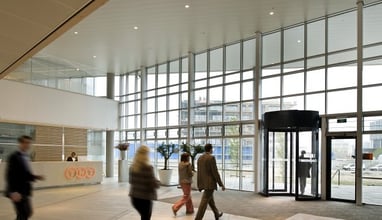With almost all buildings in the public and private environment, the entrance is, rightly, expected to be accessible to everyone. Due to the increasing aging population, it is becoming more and more important to take the elderly and people with disabilities into account.
The Comfort of Revolving Doors
As a user experience designer at Boon Edam, my goal is to ensure that our products meet the needs of all end users as closely as possible. My current research project focuses a great deal of attention on end users with a disability. We have looked at a wide spectrum of disabilities including sight and motion and the results have been intriguing.
International Accessibility Compliance and ISO 7001
The internationally recognized ITS criteria (International Accessibility Symbol) also commonly known as the ISA (International Symbol of Access) is something we have all seen in our day-to-day lives. The pictogram is a blue square overlaid with a white icon of a person sitting in a wheelchair and is associated with the ISO 7001 standard which ensures strict criteria have been met for access. Boon Edam complies with this international standard which allows us to confidently include a blue button on our automatic revolving doors.
Turning Perception Around
Practical research on the accessibility of a revolving door, as a manufacturer, is important to us and we are committed to doing more than merely meet the minimum ITS or ISA standard. Let me give you an example, we recently conducted a practical study in The Hague, during which people with a wide spectrum of limitations took a route through various types of revolving doors. The aim of the research was to observe which problems were encountered in practice, in order to better respond to these end user’s needs in our future innovations.
Operationally Compliant to ISA / ITS
The size (diameter) of a revolving door is of great influence. Our standard TQ revolving door with three door wings must have a minimum diameter of 3.4 meters according to the ITS/ISA standard laid out. Furthermore, the revolving door must be equipped with a 'slow button' (at a height of between 0.9 - 1.2 meters) on the inside and outside. When the disabled button is pushed to activate, the rotational speed of the door frame will reduce. When someone suddenly stops, the revolving door comes to a standstill by activating a contact sensor or sensor field. Also, the floor surface must have a maximum inequality of only 4 mm and the ridges have to be narrower than 4 mm. Thresholds must be less than 2 cm. Finally, there has to be a glass mark to increase the visibility of the moving parts.
Research Findings
Our field research has shown that all of our revolving doors certified according to the ITS / ISA criteria were technically accessible to the participants. At the same time, it also became clear that not all users embraced the revolving doors in the same way as others, and that there were improvements which could be made to solve any difficulties they may have experienced.
Depending on the disability of the participants, these were our observations:
- People with disabilities always strive for equality. Therefore they would like to follow the same path as all other pedestrians and not necessarily have to use a separate entrance.
- Shortage of space is the biggest obstacle for people in wheelchairs or scooters. The larger the segments in a revolving door, the more accessible the entry is for them.
- Physical limitation or the driving direction of those with a disability can hamper the usage of the blue slow button displayed on all accessible revolving door openings. Clear signage and other mounting options for this button can therefore be considered.
- Inequalities in the floor create difficulties for hand-operated wheelchairs with small wheel castors. It is therefore important to identify and correct inequalities during not only the installation but also during the lifetime of the entry, to ensure that the maximum floor inequality from the standard for automatic doors is achieved.
- Transparency in the entry is a benefit to all users, not only those with a disability. The clearer, the better to manage expectations on both sides of the entry.
- The entry also has to take into account the visually impaired. It is therefore important to prevent large differences in light, ensure sufficient contrasts and reduce blinding light reflections. Also, the use of an entrance mat in front of, in and behind the revolving door provides a better detection of the revolving door for those using a cane.
- It is very important that the space in front of and behind the entrance is freely accessible to everyone. Obstacles or a rubbish bins in the path of the entry should therefore be avoided. Also a smoking area directly at the entry can bring a negative effect on accessibility.
Knowledge is Power
All in all, this practical research offered many useful insights. The findings served as a confirmation of what we already knew, but one thing which did surprise me was how stressful a visit to a new, unknown place can be for some people. The findings make it clear how important selecting the right entry solution is. We can already enhance the users experience thanks to various applications already in place, and this type of research contributes to the further development of our products and services.

